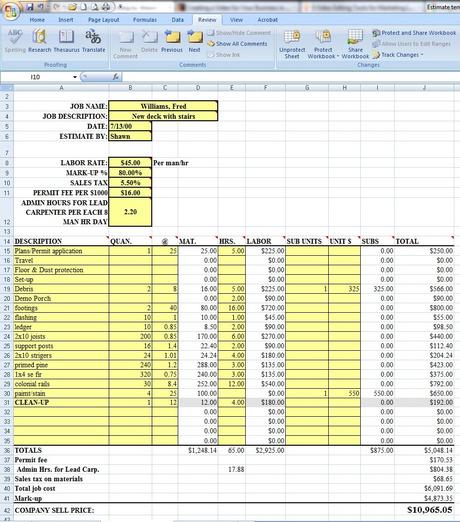 Guest Blogger: Spencer Powell, Inbound Marketing Director at TMR Direct. Spencer joined TMR Direct to spearhead their social media marketing efforts and to assist clients who want to implement social media marketing campaigns. He also specializes in helping builders and remodelers who are frustrated with the lack of leads they are getting from their current websites. Recently Shawn and Spencer have teamed up to help several of Shawn’s consulting clients. First, Shawn helps remodelers strategically identify and decide their target customer(s), project type(s) and niche(s). As an Inbound Marketing Certified Professional, Spencer and his team then help remodelers get found by their targeted prospects on the web.
Guest Blogger: Spencer Powell, Inbound Marketing Director at TMR Direct. Spencer joined TMR Direct to spearhead their social media marketing efforts and to assist clients who want to implement social media marketing campaigns. He also specializes in helping builders and remodelers who are frustrated with the lack of leads they are getting from their current websites. Recently Shawn and Spencer have teamed up to help several of Shawn’s consulting clients. First, Shawn helps remodelers strategically identify and decide their target customer(s), project type(s) and niche(s). As an Inbound Marketing Certified Professional, Spencer and his team then help remodelers get found by their targeted prospects on the web.
How Your Website Can Get You Involved in the Homeowner's Sales Cycle

Just think about it for a second. That's how you find EVERYTHING today. Yes, I'm talking about Google. If you're looking for a product or service, there's a good chance the first place you'll go is the web. This is where your research process begins. Well, it's the same for homeowners who are looking to remodel their kitchen, bathroom or any other part of their home.
Helpful information is key
So, how can you ensure that you'll be a part of their research process...and how can your website help you do that? There are a few factors that we want to look at. First, your website needs to have lots of helpful information that your prospect might be looking for. This could be information on the process of going through the design phase. It could be warning signs to look out for when selecting a contractor. It could be information on cost and why certain things cost more or less. It could be information on change orders. Think about it. The more information you can provide to your prospects, the fewer questions they'll have when they contact you.
BUT...most importantly you'll position yourself as a trusted advisor in your industry because you're the one helping them make an important decision.
Google LOVES content
 In addition to becoming a trusted advisor, the more content you create on your website, the more chances you have to actually get found in search engines like Google. Google LOVES content, so the more you create, the more you'll be found. Just think of your website like a planet. The more pages and articles you create, the bigger the planet gets, and the more gravitational pull it has. So, you'll be pulling in more web visitors.
In addition to becoming a trusted advisor, the more content you create on your website, the more chances you have to actually get found in search engines like Google. Google LOVES content, so the more you create, the more you'll be found. Just think of your website like a planet. The more pages and articles you create, the bigger the planet gets, and the more gravitational pull it has. So, you'll be pulling in more web visitors.
Once you have more prospects coming to your website because of the content, you'll notice that your website actually helps you get heavily involved in the homeowner sales cycle because you're helping them with their research. In addition, your information doesn't all have to be readily available. It's a good idea to have and offer much more in-depth information that a visitor can download. This might be in the form of an eBook like "10 Kitchen Design Trends for 2012". However, in exchange for being able to download it, they need to provide their Name, Email, Phone Number and Zip Code.
Once captured, nurture those leads!
 Now you're in great position to solidify your company as one of their options for helping them achieve their goal. This is where lead nurturing comes into play. Lead nurturing is simply sending out helpful emails with more information that helps your prospect do research. These emails allow you to stay in touch with the prospect all the way through the sales cycle. How to execute a lead nurturing campaign is the topic for another post, but are you starting to see how your website can really get you involved in the homeowner sales cycle?
Now you're in great position to solidify your company as one of their options for helping them achieve their goal. This is where lead nurturing comes into play. Lead nurturing is simply sending out helpful emails with more information that helps your prospect do research. These emails allow you to stay in touch with the prospect all the way through the sales cycle. How to execute a lead nurturing campaign is the topic for another post, but are you starting to see how your website can really get you involved in the homeowner sales cycle?
What are YOUR thoughts on this? Are any of you using your websites to participate in your prospects’ sales cycles?




 My suggestion to design/build firms is to have a decorator either on staff or one you’ve built a good relationship with available to you, that is willing to work in conjunction with the designer and/or contractor as far as the pretty aspect of such things as tile lay-out, mirror and sconce placement goes. This is where creating a team comes into play. When all parties are able to communicate clearly with one another and work together everyone wins. That’s the whole point - everyone does what they’re good at, has a good time and works together so more business is forth-coming.
My suggestion to design/build firms is to have a decorator either on staff or one you’ve built a good relationship with available to you, that is willing to work in conjunction with the designer and/or contractor as far as the pretty aspect of such things as tile lay-out, mirror and sconce placement goes. This is where creating a team comes into play. When all parties are able to communicate clearly with one another and work together everyone wins. That’s the whole point - everyone does what they’re good at, has a good time and works together so more business is forth-coming.

 So, when you determine the burdened hourly rate to use in your estimates and for job costing you can't be guessing. To get the accurate rate you must divide the total annual cost to compensate and support each employee by the number of hours he or she will be working producing income. For the example above, you must collect enough money in 1940 hours of productive time so you will have enough money to pay the employee for 2080 hours. Non-productive time and other labor related expenses are easily calculated into a burdened labor rate using a spreadsheet like the one shown above.
So, when you determine the burdened hourly rate to use in your estimates and for job costing you can't be guessing. To get the accurate rate you must divide the total annual cost to compensate and support each employee by the number of hours he or she will be working producing income. For the example above, you must collect enough money in 1940 hours of productive time so you will have enough money to pay the employee for 2080 hours. Non-productive time and other labor related expenses are easily calculated into a burdened labor rate using a spreadsheet like the one shown above. Labor cost is one of the most difficult costs to predict in an estimate. Basically, this cost is determined by calculating the hours required to complete a task or project and then factoring those estimated hours by what it costs your business per hour to compensate and support your field employees. The cost per hour to compensate and support your field employees is commonly called burdened labor costs or your burdened hourly rate.
Labor cost is one of the most difficult costs to predict in an estimate. Basically, this cost is determined by calculating the hours required to complete a task or project and then factoring those estimated hours by what it costs your business per hour to compensate and support your field employees. The cost per hour to compensate and support your field employees is commonly called burdened labor costs or your burdened hourly rate. 
 The hard cost of labor includes not only the hourly wage of the employee, but also all employer-paid taxes, Social Security, insurance, vehicle expenses, and any employee benefits. Workmen’s Compensation, liability insurance, auto insurance, paid holidays, vacations, medical benefits, education, employee meetings, cell phones, pagers, and every other labor-related expense must be factored into your hourly rates.
The hard cost of labor includes not only the hourly wage of the employee, but also all employer-paid taxes, Social Security, insurance, vehicle expenses, and any employee benefits. Workmen’s Compensation, liability insurance, auto insurance, paid holidays, vacations, medical benefits, education, employee meetings, cell phones, pagers, and every other labor-related expense must be factored into your hourly rates.  Recently there has been a lot of buzz around the remodeling and home improvement industries regarding OSHA enforcement.
Recently there has been a lot of buzz around the remodeling and home improvement industries regarding OSHA enforcement. OSHA requirements do not apply if you are the business owner and only work alone.
OSHA requirements do not apply if you are the business owner and only work alone. Below is short a list of things contractors should consider if they want to be ready when an OSHA Inspector drives by and or stops in to check out your job site.
Below is short a list of things contractors should consider if they want to be ready when an OSHA Inspector drives by and or stops in to check out your job site.
 They may be challenged if no longer the one in control of the design process, the construction methods and the client.
They may be challenged if no longer the one in control of the design process, the construction methods and the client. Will they refer you to their own clients?
Will they refer you to their own clients?
 An experienced Management Team that has created and follows a strategic and sustainable business plan, implements industry best practices and continuously identifies and mentors strong leadership within the team in each department.
An experienced Management Team that has created and follows a strategic and sustainable business plan, implements industry best practices and continuously identifies and mentors strong leadership within the team in each department. A
A 
 A Design System that properly identifies and documents the information needed by the client as well as the Design/Builder's project team and serves as a communication tool to make sure the design and final project serve the client's purposes within the agreed budget and timeline
A Design System that properly identifies and documents the information needed by the client as well as the Design/Builder's project team and serves as a communication tool to make sure the design and final project serve the client's purposes within the agreed budget and timeline A
A  Knowing what to charge clients for the work you do is often the difference between long term success and eventual failure for the business. Many contractors look at estimating simply as a way to determine the cost of a project. In the traditional design-bid model of project delivery, this simplistic approach may work, assuming your sell price generates enough gross profit to cover your overhead and profit requirements. However, if you’re doing design/build, and your current estimating system is limited to only producing the number you charge clients for a project, you may be missing out on many other possible benefits.
Knowing what to charge clients for the work you do is often the difference between long term success and eventual failure for the business. Many contractors look at estimating simply as a way to determine the cost of a project. In the traditional design-bid model of project delivery, this simplistic approach may work, assuming your sell price generates enough gross profit to cover your overhead and profit requirements. However, if you’re doing design/build, and your current estimating system is limited to only producing the number you charge clients for a project, you may be missing out on many other possible benefits. If you think of Design/Build as a way of doing business, your estimating system must become a tool that facilitates how you do business, not just a way to get to the price. Here are several ways a Design/Builder or a remodeler can maximize the potential of the method and system used to do estimating:
If you think of Design/Build as a way of doing business, your estimating system must become a tool that facilitates how you do business, not just a way to get to the price. Here are several ways a Design/Builder or a remodeler can maximize the potential of the method and system used to do estimating:

 Thanks for your question. It’s a great one! I’m glad you are asking before you start out on your own. That makes you very different than most.
Thanks for your question. It’s a great one! I’m glad you are asking before you start out on your own. That makes you very different than most. 
 Professional Remodeling Management
Professional Remodeling Management A long time ago a remodeler in my NARI Chapter who was just starting his business asked me for advice about how he too could have a successful and profitable business. Seeking to keep my response simple and to the point I came up with a list of nine steps. When I was explaining my list to him he asked where he would find the time to do all these things. He said he was already straight out trying to sell and complete work. That’s when I added step number one to the ten step list below.
A long time ago a remodeler in my NARI Chapter who was just starting his business asked me for advice about how he too could have a successful and profitable business. Seeking to keep my response simple and to the point I came up with a list of nine steps. When I was explaining my list to him he asked where he would find the time to do all these things. He said he was already straight out trying to sell and complete work. That’s when I added step number one to the ten step list below.  Recharge Your Batteries!
Recharge Your Batteries!





